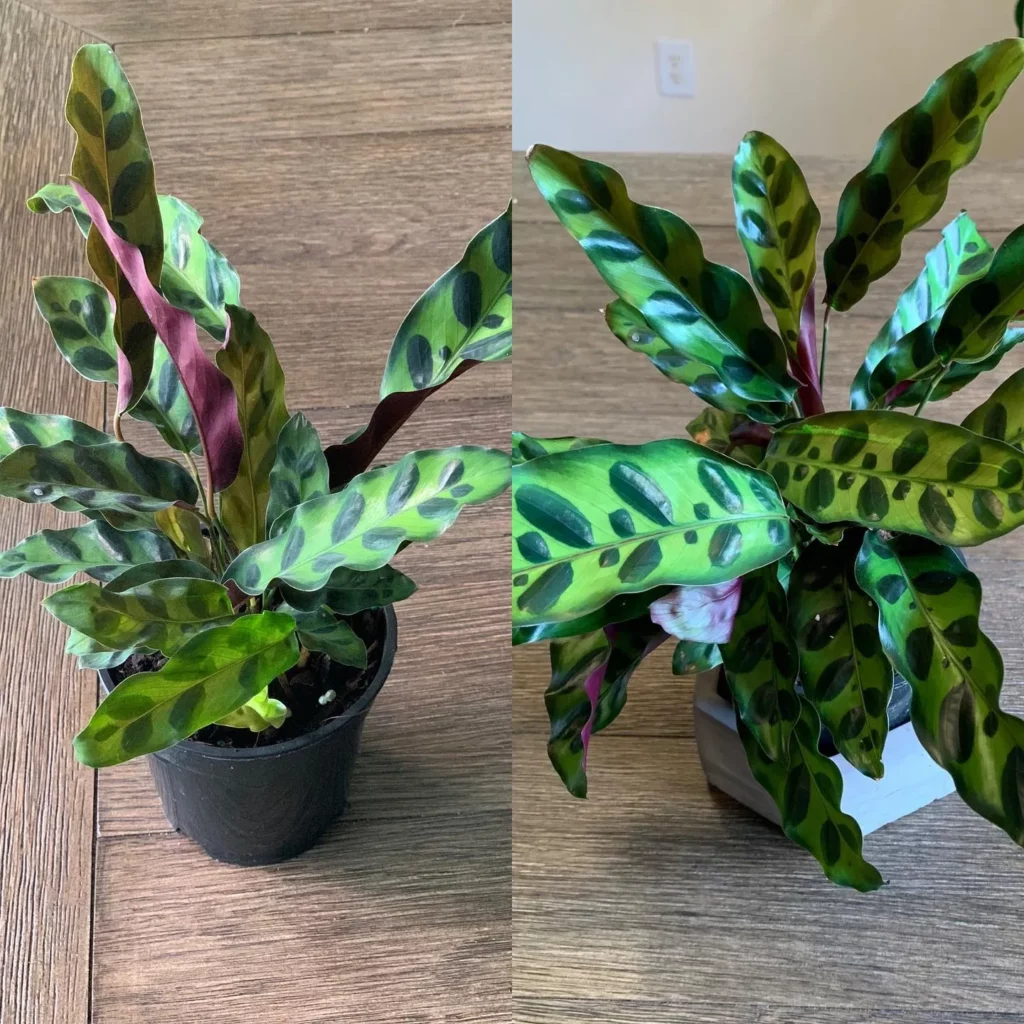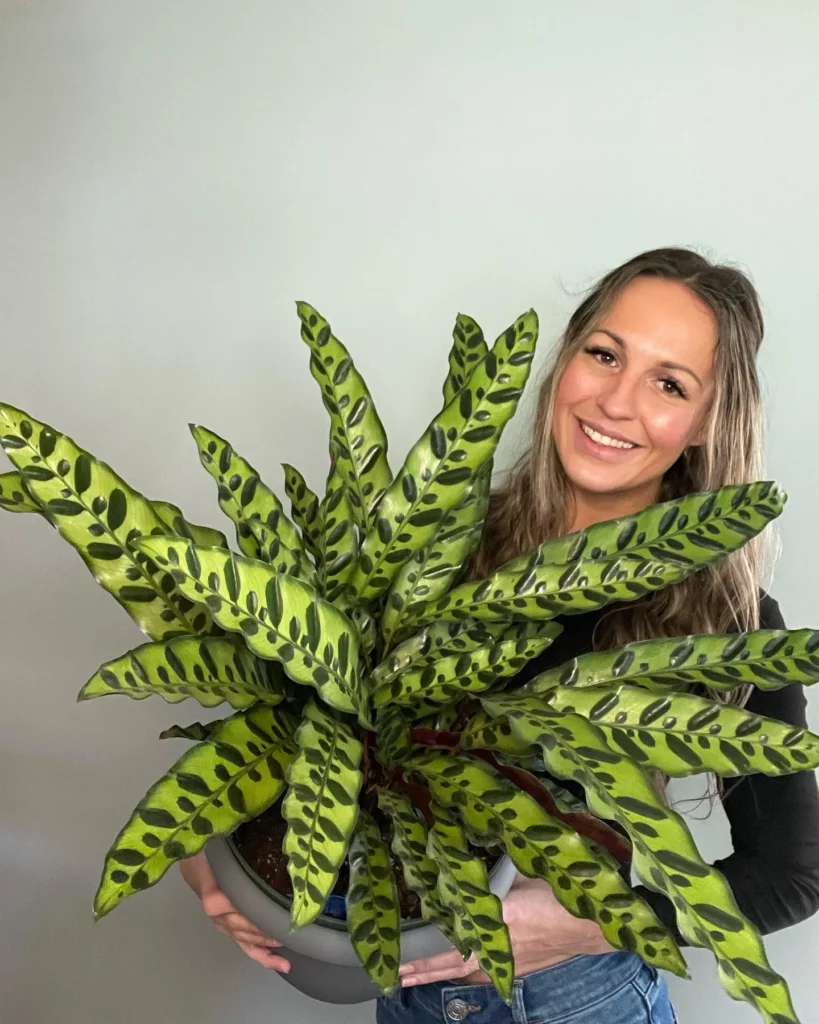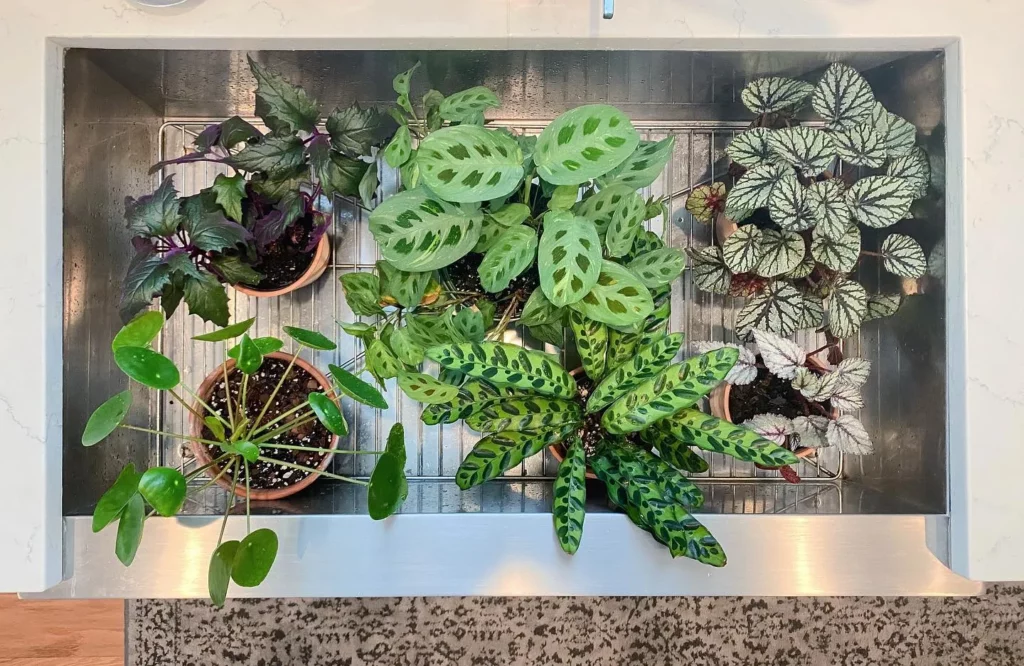The rattlesnake plant, also known as prayer plant or rattlesnake calathea, is a beautiful tropical houseplant that adds a touch of elegance to any indoor space. Its long, lance-shaped leaves are a sight to behold, featuring a distinctive wavy pattern along the edges. The leaves are variegated with shades of green, creating a captivating display of colors. But it doesn’t stop there – the undersides of the leaves are equally stunning, with beautiful purplish-red tones that add depth and contrast to the overall appearance.
Appearance of Rattlesnake Plant



While the rattlesnake plant rarely blooms indoors, its foliage more than makes up for it. The unique leaf patterns and colors are the main attraction, making this plant a focal point of any room. When grown as a houseplant, the rattlesnake plant typically reaches a height of 9 to 20 inches, making it a perfect choice for tabletops, shelves, or as part of a larger indoor garden display.
With its long, elegant leaves and striking colors, the rattlesnake plant is sure to add a touch of natural beauty to your home or office. Whether you’re a seasoned plant enthusiast or just starting out, this tropical houseplant is a great choice for bringing a bit of the jungle indoors.
Light Requirements for Rattlesnake Plant

Rattlesnake plants, also known as prayer plants or rattlesnake calatheas, have specific light requirements to thrive and maintain their beautiful foliage. These tropical houseplants prefer filtered light or bright, indirect sunlight. It’s important to avoid placing them in locations with intense afternoon sun streaming through the window, as direct sunlight can scorch their leaves.
If you choose to place your rattlesnake plant near a window, consider using drapes or selecting a window without direct sunlight to diffuse the light. This will prevent any potential damage to the leaves from excessive heat or brightness. Alternatively, you can place the plant in a well-lit room that provides bright, indirect light throughout the day. These plants naturally grow in shaded outdoor landscapes, so replicating those light conditions indoors is crucial for their overall health.
To give you a better understanding of the desired light conditions for your rattlesnake plant, here is a simple breakdown:
- Filtered light
- Bright, indirect sunlight
- Avoid intense afternoon sun
| Light Conditions | Placement |
|---|---|
| Filtered light | Place away from direct sunlight, such as near a sheer curtain or in a room with moderate light. |
| Bright, indirect sunlight | Find a well-lit spot that doesn’t receive direct sunlight, such as near a north-facing window. |
| Avoid intense afternoon sun | Keep away from windows or areas with strong afternoon sun, which can cause leaf burn. |
Watering Rattlesnake Plant



Rattlesnake plants prefer to be kept moist but not waterlogged. Proper watering is crucial for the health and well-being of your rattlesnake plant. Here are some essential tips to keep in mind:
No products found.
- Summer Watering: During the summer months, when the plant is in its active growth phase, it’s necessary to water the rattlesnake plant frequently. This helps to maintain a consistently moist soil or potting mix, which supports healthy growth.
- Winter Watering: In the winter season, the watering frequency should be adjusted. Allow the top layer of soil to dry out before watering again. This prevents overwatering and ensures that the roots do not sit in excess moisture, which can lead to root rot.
- Small, Regular Waterings: Rather than deep irrigation, it’s better to provide the plant with frequent small waterings. This allows the roots to absorb water more efficiently and prevents water from pooling at the bottom of the pot.
- Drainage: When watering your rattlesnake plant, make sure to pour water until it just starts to trickle out of the drainage holes at the bottom of the pot. This ensures that any excess water drains out, preventing waterlogging.
- Monitoring: Keep a close eye on your plant’s watering needs. Check the moisture level of the soil regularly by touching it with your finger. If the top inch of soil feels dry, it’s time to water your rattlesnake plant.
Fertilizing Rattlesnake Plant

| Fertilizer Type | Application Frequency | Application Method |
|---|---|---|
| Balanced liquid fertilizer | Monthly | Dilute fertilizer according to label instructions and water the plant with the solution. |
Rattlesnake plants benefit from regular fertilization during the spring and summer growing season. Using a balanced liquid fertilizer once a month helps encourage healthy foliage development. It’s important to follow the product label instructions for the correct amount to use. Applying too much fertilizer can harm the plant, while too little may result in nutrient deficiencies. Dilute the fertilizer according to the instructions and water the plant with the solution to ensure proper distribution of nutrients.
Potting Rattlesnake Plant



When it comes to potting your rattlesnake plant, there are a few key considerations to keep in mind. The right pot and soil can make all the difference in providing a suitable environment for your plant to thrive.
To start, choose a pot with drainage holes to prevent waterlogging. This allows excess water to escape and helps prevent root rot. If you prefer a decorative pot without drainage holes, you can double pot by using a plastic pot with drainage and placing it inside the decorative pot.
Next, the soil should be well-draining but still able to retain moisture. A mixture of peat moss, perlite, and potting soil works well for rattlesnake plants. This combination provides adequate drainage while retaining the moisture necessary for healthy growth.
When it’s time to repot your rattlesnake plant, select a pot that is slightly larger than the current root ball. This allows room for the plant to grow and establish new roots. Repotting is typically recommended every year or two to encourage growth and freshen up the soil.
Proper potting plays a crucial role in supporting the overall health of your rattlesnake plant. By providing the right pot and soil conditions, you can create an ideal growing environment for your plant to flourish.
No products found.
Propagation of Rattlesnake Plant

If you want to expand your rattlesnake plant collection or share the joy of growing these unique houseplants with friends and family, propagation through division is a great option. This process involves separating the plant into smaller sections and potting them individually, giving each section the opportunity to develop into a new plant.
To propagate your rattlesnake plant, you should begin when you are planning to repot the plant anyway. This allows you to easily access the root system and divide it without causing too much disturbance.
Here’s a step-by-step guide to propagating your rattlesnake plant:
- Carefully remove the plant from its current pot, gently untangling the root ball.
- Look for natural divisions in the root ball, where there are separate sections with their own sets of roots and shoots.
- Using clean, sharp gardening shears or a clean knife, carefully separate these sections, ensuring that each section has enough roots and shoots to support its growth.
- Prepare appropriately sized pots for each section, ensuring they have good drainage.
- Fill the pots with well-draining soil, such as a mixture of peat moss, perlite, and potting soil.
- Plant each section in its own pot, making sure the roots are well-covered with soil and gently pressing the soil around the base of the plant.
- Water each newly potted section thoroughly, allowing the water to fully penetrate the soil and drain out through the drainage holes.
It’s important to provide adequate care and attention to the newly propagated plants. Keep them in a well-lit area with indirect sunlight and maintain proper watering and fertilization practices.
Propagation Tips:
- Propagation through division is best done in the spring when the plants are actively growing.
- Make sure each divided section has its own healthy set of roots and shoots to ensure its survival.
- Use clean tools to prevent the spread of diseases or pests.
- Choose appropriately sized pots to accommodate the growth of each section.
- Water thoroughly after potting to help settle the soil and provide moisture to the newly propagated plants.
- Keep the newly propagated plants in a warm and humid environment to promote growth.
| Propagation Method | Description | Difficulty |
|---|---|---|
| Division | Separating the plant into smaller sections and potting them individually. | Easy |
| Leaf Cuttings | Planting a leaf cutting in soil or water to develop new roots and shoots. | Moderate |
| Stem Cuttings | Planting a stem cutting in soil or water to encourage new root and shoot development. | Moderate |
Growth and Development of Rattlesnake Plant



Rattlesnake plants, also known as prayer plants, exhibit moderate growth indoors. However, their growth may slow down or halt if they are exposed to unfavorable conditions. When cared for properly, these tropical houseplants can reach a height of 9 to 20 inches.
Pruning rattlesnake plants is generally unnecessary, but removing dead or drying leaves can help maintain their overall appearance. It is essential to understand the unique leaf movements of these plants. Some varieties of rattlesnake plants have leaves that point upward at night and drop back down during the day, earning them the name “prayer plant.”
Proper understanding of the growth and development patterns of rattlesnake plants is vital to provide them with the appropriate care and nurturing they need. Check out the table below for a summary of the growth and development characteristics of rattlesnake plants:
| Characteristics | Description |
|---|---|
| Growth Rate | Moderate |
| Maximum Height | 9 to 20 inches |
| Pruning | Generally not necessary, but removing dead or drying leaves can maintain appearance |
| Leaf Movements | Some varieties exhibit upward-pointing leaves at night and downward-dropping leaves during the day |
Pests and Diseases of Rattlesnake Plant
Rattlesnake plants, like any other houseplant, are vulnerable to pests and diseases. Common pests that can infest your rattlesnake plant include aphids, mealybugs, and spider mites. It’s important to regularly inspect the leaves, especially the undersides, for any signs of infestation.
No products found.
If you notice pests on your rattlesnake plant, don’t panic. There are several effective ways to treat these issues. You can use gentle insecticidal soap or neem oil, following the instructions on the product. Alternatively, you can manually remove the pests by gently wiping the leaves and stems with a soft cloth dipped in soapy water.
While pests can be a nuisance, it’s also crucial to pay attention to the leaves and stems for signs of watering or environmental issues. Overwatering can cause the leaves to turn yellow, while brown leaf edges may indicate a need for more humidity. By providing the proper care and promptly addressing any potential problems, you can ensure that your rattlesnake plant remains healthy and vibrant.
FAQ
How tall does a rattlesnake plant grow?
Rattlesnake plants typically reach a height of 9 to 20 inches when grown as houseplants.
What does the foliage of a rattlesnake plant look like?
The leaves of the rattlesnake plant have a wavy pattern along the edges and are variegated with shades of green. The undersides of the leaves are also striking, with beautiful purplish-red tones.
Does a rattlesnake plant bloom indoors?
Rattlesnake plants rarely bloom indoors, but they produce small yellow flowers in their native habitat during late spring.
What kind of light does a rattlesnake plant prefer?
Rattlesnake plants prefer filtered light or bright, indirect sunlight. They should not be placed in a location with intense afternoon sun.
How often should I water my rattlesnake plant?
Rattlesnake plants prefer to be kept moist but not waterlogged. During the summer months, they should be watered frequently to keep the soil consistently moist. In the winter, allow the top layer of soil to dry out before watering again.
How often should I fertilize my rattlesnake plant?
Rattlesnake plants benefit from monthly fertilization during the spring and summer growing season. Use a balanced liquid fertilizer and follow the product label instructions for the correct amount to use.
What kind of potting mix should I use for a rattlesnake plant?
Rattlesnake plants require a well-draining potting mix that retains moisture. A mixture of peat moss, perlite, and potting soil works well for these plants.
How can I propagate a rattlesnake plant?
Rattlesnake plants can be propagated through division. When repotting the plant, carefully untangle the root ball and separate it into smaller sections. Each section should have its own roots and shoots.
Does a rattlesnake plant require pruning?
Pruning is generally not necessary for rattlesnake plants, but you can remove dead or drying leaves to maintain the overall appearance of the plant.
What pests and diseases are common for rattlesnake plants?
Rattlesnake plants can be susceptible to pests such as aphids, mealybugs, and spider mites. Regularly check the leaves for signs of infestation and treat pest issues promptly. The leaves and stems can also indicate problems with watering or environmental conditions.





